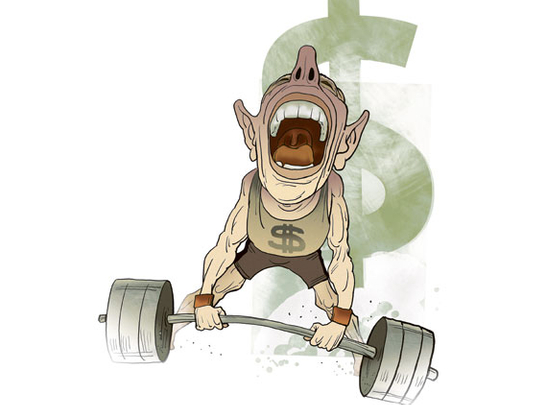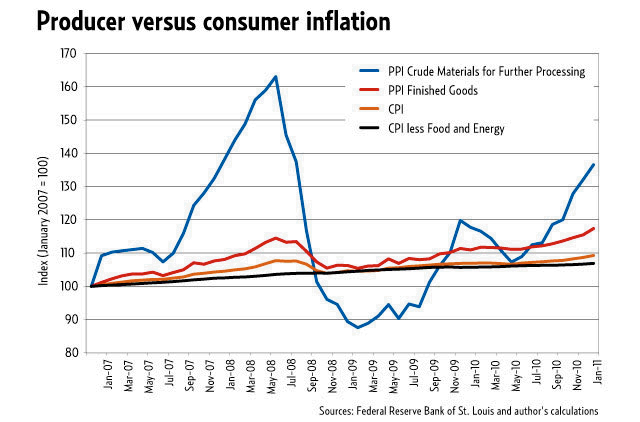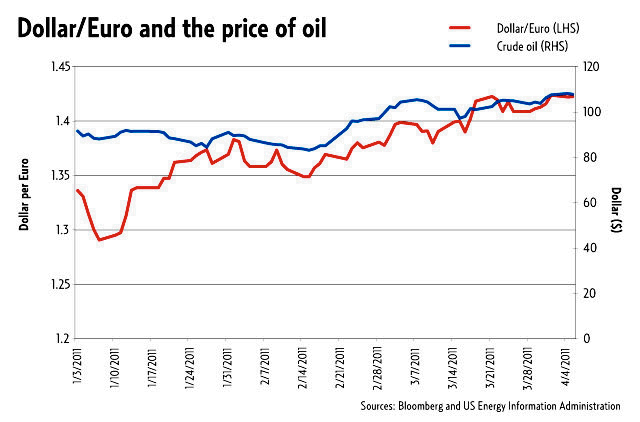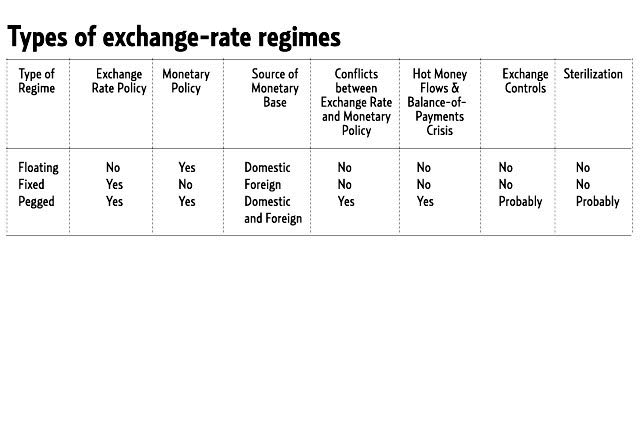
The Chairman of the Federal Reserve Ben S. Bernanke has embraced a weak dollar policy. And he is not alone. The weak dollar mantra is very much in evidence on most of the boulevards and in the back alleys of Washington. The idea even has a certain appeal to the common man on the street. After all, a cheap dollar is advertised as an export stimulant and the fuel for an economic boom. But, the common man is often wrong, and so is Chairman Bernanke.
About the only thing that has boomed during the last two years are prices, particularly commodity prices. The accompanying chart traces the producer price index for both crude materials (primarily food and energy) and for finished goods. Measured by both of these sensitive metrics, prices are booming, with the PPI for crude materials up by 14 per cent since the Fed announced its second quantitative easing programme in November 2010.
But those prices are not the ones that Bernanke and his inflation-targeting colleagues at the Fed are looking at. Rather, they focus on the consumer price index, absent food and energy. By doing so, they exclude those items that are experiencing price surges. Never mind. The Chairman and his colleagues continue to play down the inflation threat. But the public isn't buying their story. Most people are going to the petrol station and grocery store several times a week and know what's happening to petrol and food prices. Not surprisingly, the credibility of the Fed has all but disappeared, with even the taxman commanding more favourable ratings.
If the Fed is in denial about the inflation threat, it's blind to the possibility that the weak dollar is causing energy and food prices to surge. Oil and most other food and industrial commodities are invoiced in dollars. Accordingly, when the dollar goes "down" the price of primary commodities tend to automatically go "up," and vice versa.
The accompanying chart, which traces the course of the US dollar-euro exchange rate and the price of crude oil since January 2011, tells the story. During that period, the dollar has lost value against the euro and the price of oil has increased. For each one per cent decline in the dollar against the euro, there was on average a 0.5 per cent increase in the price of oil. The biggest single contributor to oil price increases in recent months is not located in Libya, but at the headquarters of the Federal Reserve in Washington.
This is not the end of the dollar story, however. The US, working through various international forums, such as the Group of 20 (G20), advocates "enhancing exchange rate flexibility to better reflect underlying economic fundamentals and structural reforms." This language is broadly understood as code for advocating floating exchange-rate regimes, particularly in the case of China. Accordingly, it implies an anti-currency bloc stance.
Since many countries link — either tightly or loosely — their currencies to the US dollar, "exchange-rate flexibility" is, at best, problematic. At its worst, the US (G20) position threatens the entire foundation of countries — like the oil producers in the Arabian Gulf — that are, out of necessity, firmly in the dollar bloc.
The currency bloc countries should embrace and advocate "flexibility," too. But they should, unlike the G20, define exactly what, in the context of exchange-rate regimes, the term "flexibility" means.
One target at a time
Strictly fixed and floating exchange rates are regimes in which the monetary authority is aiming for only one target at a time. Although floating and fixed rates appear dissimilar, they are members of the same free-market family. Both operate without exchange controls or sterilization, and both are free-market mechanisms for balance-of-payments adjustments and the supply of convertible currencies (see the accompanying table). With a floating rate, a central bank sets a monetary policy but has no exchange rate policy — the exchange rate is on autopilot. In consequence, the monetary base is determined domestically by a central bank. With a fixed rate, or what is often referred to as a unified currency, there are two possibilities: either a currency board sets the exchange rate, but has no monetary policy — the money supply is on autopilot — or a country is "dollarized" and uses foreign currency as its own.
Accordingly, under a fixed-rate regime, a country's monetary base is determined by the balance of payments, moving in a one-to-one correspondence with changes in its foreign reserves.
With both of these free-market exchange rate mechanisms, there cannot be conflicts between monetary and exchange rate policies, and balance-of-payments crises cannot rear their ugly heads. Floating and fixed-rate regimes are inherently equilibrium systems in which market forces act to automatically rebalance financial flows and avert balance-of-payments crises.
Both floating and fixed exchange-rate regimes provide flexibility — namely, automaticity, currency convertibility, no exchange controls and no sterilization.
Accordingly, the so-called global imbalance problems are not problems. Either a floating or a fixed-rate regime will automatically act to steer global savings to its most wanted destination. As a result, excess savings relative to investment opportunity in some parts of the world flow into other parts where savings are in scare supply relative to investment opportunity. The invisible hand of market forces distributes savings efficiently across the globe.
Most economists use "fixed" and "pegged" as interchangeable, or nearly interchangeable, terms for exchange rates. But, while superficially similar, they are basically very different exchange-rate arrangements. Pegged-rate systems are those where the monetary authority is aiming for more than one target at a time. They often employ exchange controls and sterilisation, and are not free-market mechanisms for international balance-of-payments adjustments. The currencies produced in some pegged exchange regimes — such as China's — are not even convertible.
Inherently disequilibrium systems
Pegged exchange rates are inherently disequilibrium systems, lacking an automatic mechanism to produce balance-of-payments adjustments. Pegged rates require a central bank to manage both the exchange rate and monetary policy. With a pegged rate, the monetary base contains both domestic and foreign components.
Unlike floating and fixed rates, pegged rates invariably result in conflicts between monetary and exchange rate policies. For example, when capital inflows become "excessive" under a pegged system, a central bank often attempts to sterilize the ensuing increase in the foreign component of the monetary base by selling bonds, reducing the domestic component of the base. And when outflows become "excessive," a central bank attempts to offset the decrease in the foreign component of the base by buying bonds, increasing the domestic component of the monetary base.
Balance-of-payments crises erupt as a central bank begins to offset more and more of the reduction in the foreign component of the monetary base with domestically created base money. When this occurs, it is only a matter of time before currency speculators spot the contradictions between exchange rate and monetary policies and force a devaluation, the imposition of exchange controls, or both.
In today's environment, "excessive" outflows and the threat of devaluations do not represent the problem facing most countries with pegged rates. Rather, "excessive" capital inflows represent today's problem. These inflows often result in currency appreciation pressures, very large sterilisation activities, the accumulation of foreign-exchange reserves and even the imposition of exchange controls and new regulatory mandates in the domestic banking system.
To protect themselves, the currency bloc countries should explain what exchange-rate flexibility means to the them: full currency convertibility, no exchange controls and no sterilization. In that context, either a floating or a fixed-rate regime qualify as free-market mechanisms that work to automatically avoid balance-of-payments crises and so-called global imbalance problems.
For the countries — like the oil producers in the Arabian Gulf — the US dollar bloc and fixed exchange rates are a necessity. These countries are mono-product economies, and their "product," oil, is invoiced in dollars. Accordingly, if a floating exchange-rate regime were adopted, their nominal exchange rates would fluctuate erratically as oil prices fluctuate. When the price of oil rises (falls), the local currencies would appreciate (depreciate). Without a currency link to the dollar and a nominal anchor for its price level, the oil producing countries would experience a wild roller-coaster ride — one distinguished by deflationary lows and inflationary highs.
Thanks to the Fed's weak dollar policy, the US faces an inflation problem and so does the rest of the world. The weak dollar and the lack of "flexibility" — properly understood — also threaten the free flow of capital and the stability of the international monetary system. It's time for the Fed to start focusing on the value and stability of the US dollar.
The writer is a Professor of Applied Economics at The Johns Hopkins University in Baltimore and a Senior Fellow at the Cato Institute in Washington.















